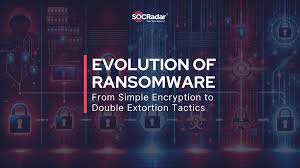Ransomware has evolved from a simple digital nuisance into a sophisticated, multi-billion dollar criminal enterprise that poses a significant threat to businesses, governments, and individuals worldwide. Its core concept—denying access to data until a ransom is paid—has remained, but the tactics used to apply pressure have become terrifyingly more complex and potent. What started as a simple lock screen has morphed into a multi-layered extortion crisis.
The Genesis: Scareware and Screen Lockers
The earliest forms of ransomware, dating back to the late 1980s with the "AIDS Trojan," were rudimentary. However, the first major wave that gained public attention in the 2000s and early 2010s consisted primarily of screen lockers.
These malicious programs would simply freeze a user's screen, displaying a menacing message often impersonating law enforcement (like the FBI or local police). The message would accuse the user of illegal online activity and demand a "fine" to unlock the computer. While alarming, this type of malware was relatively easy to remove for a tech-savvy user, as it didn't actually encrypt the underlying files. It was more scareware than a true data hostage situation.
The Game Changer: The Dawn of Crypto-Ransomware
The entire landscape shifted dramatically around 2013 with the arrival of CryptoLocker. This was a pivotal moment in cybercrime history. Instead of just locking the screen, CryptoLocker used powerful asymmetric encryption (a combination of public and private key cryptography) to scramble the victim's files—documents, photos, and databases.
Suddenly, the data itself was the hostage. The mathematical complexity of the encryption meant that without the attacker's private key, recovering the files was practically impossible. This innovation transformed ransomware from an annoyance into a devastating weapon. Victims were now faced with a stark choice: pay the ransom (usually in Bitcoin) or lose their data forever. This model proved so successful that it spawned countless imitators like WannaCry and Petya, which caused global disruptions.
The Pressure Cooker: Double, Triple, and Quadruple Extortion
For years, the primary defense against crypto-ransomware was a robust backup strategy. If you had clean copies of your data, you could restore your systems and ignore the ransom demand. Cybercriminals, realizing their leverage was being undermined, evolved their tactics once again.
Double Extortion
Pioneered by ransomware groups like Maze around 2019, double extortion added a devastating new layer. Before encrypting a victim's network, attackers now spend time exfiltrating—or stealing—large amounts of sensitive data.
- Encryption: They lock the files as usual.
- Threat of Publication: They threaten to leak the stolen data publicly on "leak sites" if the ransom isn't paid.
This masterstroke nullified the "backup defense." Even if a company could restore its operations, it now faced the risk of severe regulatory fines (for violating laws like GDPR or HIPAA), loss of customer trust, and public humiliation.
Triple & Quadruple Extortion
As if that weren't enough, threat actors have continued to add more layers of pressure:
- Triple Extortion: This tactic adds a Distributed Denial-of-Service (DDoS) attack. If the victim refuses to pay, the criminals flood their servers with traffic, knocking their website and online services offline, thus halting business operations and adding another dimension of financial pain.
- Quadruple Extortion: This is the most personal and aggressive tactic. Attackers bypass the corporate communications team and contact the victim's customers, business partners, employees, and the media directly. They inform them of the breach, share samples of their stolen data, and create a PR nightmare designed to force the victim's hand.
The Modern Ecosystem: Big Game Hunting and RaaS
Today's ransomware landscape is a professionalized industry. Instead of opportunistic "spray and pray" attacks, top-tier criminal groups engage in "Big Game Hunting"—meticulously targeting large, wealthy organizations that can afford multi-million dollar ransoms.
This is powered by the Ransomware-as-a-Service (RaaS) model. RaaS operates like a legitimate software-as-a-service business. A core group of developers creates and maintains the ransomware, then leases it out to "affiliates." These affiliates are responsible for hacking the victims, deploying the ransomware, and negotiating the payment, after which they split the profits with the developers. This has dramatically lowered the barrier to entry, allowing a wider pool of criminals to launch sophisticated attacks.
The future likely holds even more advanced threats, including the use of AI to create more evasive malware and identify high-value targets. As our world becomes more connected through the Internet of Things (IoT), the attack surface will only grow, presenting new opportunities for extortion. The evolution is far from over.

